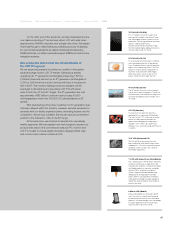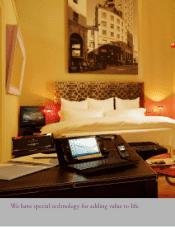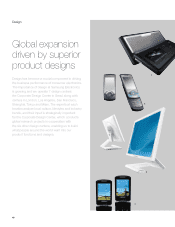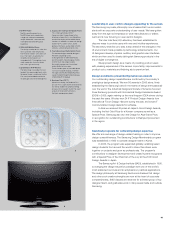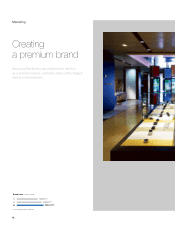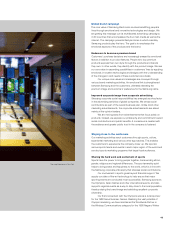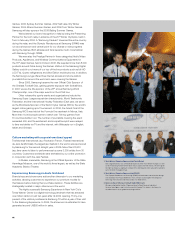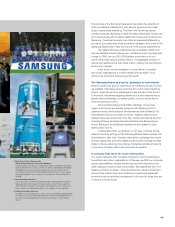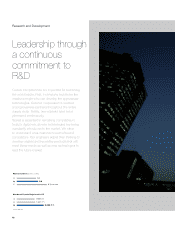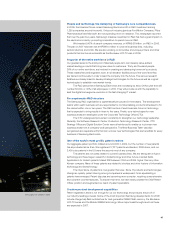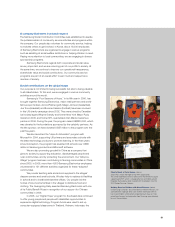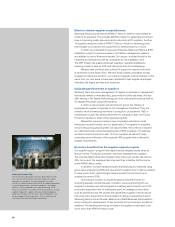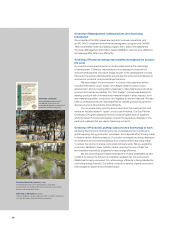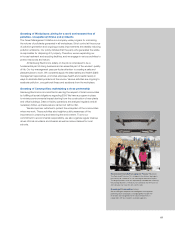Samsung 2006 Annual Report Download - page 57
Download and view the complete annual report
Please find page 57 of the 2006 Samsung annual report below. You can navigate through the pages in the report by either clicking on the pages listed below, or by using the keyword search tool below to find specific information within the annual report.
47
People and technology, the wellspring of Samsung’s core competitiveness
In 2006, the Financial Times ranked Samsung Electronics 9th in R&D investment among
1,250 companies around the world. Only such industry giants as Ford Motor Company, Pfizer
Pharmaceutical and Microsoft are now spending more on research. This newspaper reported
that over the past four years, Samsung’s massive investment in R&D has had a great impact on
the electronics industry, prompting competitors to spend more on R&D.
We invested 9.42% of parent company revenues, or KRW5.58 trillion, on R&D in 2006.
The plan in 2007 has been set at KRW6.14 trillion to cover all business lines, including
semiconductors and LCDs. We are also working on innovative and unique printers and other
products that can be as successful as the Bordeaux LCD TV was in 2006.
A quarter of the entire workforce in R&D
Our greatest asset is the solid pool of talented people who can develop value-added,
market-leading products that bring new value to customers. Thirty-six thousand people,
26% of our entire workforce, are involved in creating and developing tomorrow’s products.
These researchers and engineers work at 42 research facilities around the world and they
are trained continuously in order to lead the company into the future. The various research
facilities are closely linked to develop strategic technologies for the future as well as original
technologies to establish new market trends.
The R&D personnel at Samsung Electronics are increasing by about 20% a year and will
number 52,000, or 32% of all employees, in 2010. They will provide us with the capability to
lead the digital convergence revolution in the fast-changing IT market.
For a systematic R&D structure
The Samsung R&D organization is systematically structured in three layers. The development
teams within each business unit are responsible for commercializing products scheduled to hit
the market within one or two years. The R&D centers of each business focus on technology
that is expected to bring results in three to five years. Finally, core technologies for new
business areas are developed under the Corporate Technology Office (CTO).
The CTO undergoes improvement constantly to strengthen our technology leadership.
Recently, the Software Research Center, Production Technology Research Center, CTO
Strategy Office and Digital Solution Center were all reinforced to enable us to pioneer new
business areas from a company-wide perspective. The New Business Team was also
reorganized as a separate entity that can uncover new technologies that are beneficial for every
business of Samsung Electronics.
One of the world’s most prolific patent creators
Our aggregate patent portfolio totaled around 9,000 in 2002, but the number of new patents
has skyrocketed since then. We registered 17,377 patents worldwide in 2006 alone, and our
2,400-plus patents in the US were the second most of any company.
The patents are not solely related to current business lines. We are taking aim at fusion
technology and have begun research in biotechnology and other future-oriented fields.
Applications for biotech patents totaled 208 between 2004 and 2006, higher than any other
Korean company. Many of these patents are related to biochips and other fusions of information
technology and biotechnology.
The importance of patents is now greater than ever. Since IT products and technologies
change so quickly, patent sharing among companies is widespread. Firms specializing in
patents have emerged. Patent disputes are becoming more complex, requiring comprehensive
and constant countermeasures. To answer this trend, we have newly created the Chief Patent
Officer position and augmented our team of patent specialists.
Creative product development capabilities
Patent registration alone is not enough for us; our technology and products are proof of
our industry leading prowess. Some of the most important Samsung developments for 2006
include charge trap flash architecture for next-generation NAND flash memory, the Bordeaux
LCD TV series and the Mobile WiMAX technology. More major breakthroughs such as these
are expected in 2007.
Samsung Suwon Complex in Korea


